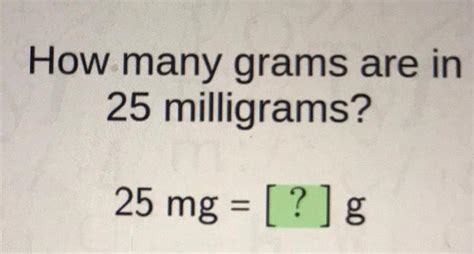How Many Grams Are In 25 Mg
Kalali
Mar 31, 2025 · 4 min read

Table of Contents
How Many Grams Are in 25 mg? A Comprehensive Guide to Metric Conversions
Understanding metric conversions is crucial in various fields, from cooking and medicine to scientific research and engineering. One common conversion involves milligrams (mg) and grams (g), units of mass in the metric system. This comprehensive guide will delve into the conversion of 25 mg to grams, explaining the process, providing practical examples, and exploring the broader context of metric unit conversions.
Understanding the Metric System
The metric system, also known as the International System of Units (SI), is a decimal system based on powers of 10. This means that units are related by factors of 10, making conversions relatively straightforward. The fundamental unit of mass in the metric system is the kilogram (kg), but we often work with smaller units like grams (g) and milligrams (mg).
The Relationship Between Grams and Milligrams
The prefix "milli" signifies one-thousandth (1/1000). Therefore, one gram (g) is equal to 1000 milligrams (mg). This fundamental relationship is the key to converting between these two units.
Converting 25 mg to Grams
To convert 25 mg to grams, we use the conversion factor: 1 g = 1000 mg. We can set up a simple proportion:
25 mg * (1 g / 1000 mg) = x g
Notice how the "mg" units cancel out, leaving us with grams. Solving for x:
x = 25 / 1000 g = 0.025 g
Therefore, there are 0.025 grams in 25 milligrams.
Practical Applications and Examples
Understanding this conversion is vital in various scenarios:
-
Medicine: Many medications are prescribed in milligrams, but their overall dosage might be expressed in grams. For example, a patient might receive 25 mg of a particular drug, which is equivalent to 0.025 g. Nurses and pharmacists must accurately convert units to ensure correct dosage administration.
-
Science: In scientific experiments, precise measurements are critical. Researchers often work with small quantities of materials, and converting between mg and g ensures accurate recording and analysis of data. Imagine measuring the mass of a chemical compound in an experiment; a precise conversion is essential for reproducibility and accuracy.
-
Cooking and Baking: While less common than in scientific or medical settings, converting milligrams to grams can be helpful in recipes that require very precise ingredient measurements. Some specialized recipes may call for a specific amount of a spice or ingredient measured in milligrams.
-
Jewelry Making: In the creation of fine jewelry, precious metals such as gold are often measured in milligrams when dealing with small components. Converting this to grams helps in calculating the total weight of a piece.
Further Metric Conversions
The metric system extends beyond grams and milligrams. Understanding the relationships between other units is also important. For instance:
-
Kilograms (kg): 1 kg = 1000 g. Therefore, 0.025 g is equal to 0.000025 kg.
-
Micrograms (µg): 1 g = 1,000,000 µg. Therefore, 25 mg is equal to 25,000 µg.
-
Tonnes (t): 1 t = 1,000,000 g. Therefore, 0.025 g is equal to 0.000000025 t.
Mastering Metric Conversions: Tips and Tricks
Successfully converting between metric units requires a solid understanding of the prefixes and their corresponding numerical values. Here are some tips:
-
Memorize the prefixes: Familiarize yourself with common prefixes like milli-, kilo-, centi-, and micro-.
-
Use conversion factors: Always use conversion factors to ensure accuracy. Setting up proportions, as shown earlier, is a helpful method.
-
Practice regularly: The more you practice converting units, the easier it becomes. Try working through different examples to solidify your understanding.
-
Use online calculators: While it's crucial to understand the process, online metric conversion calculators can be helpful for checking your work and saving time.
-
Double-check your work: Always double-check your calculations to avoid errors, particularly in contexts where precision is critical.
Beyond the Conversion: The Importance of Unit Accuracy
Accurate unit conversion isn't just about getting the right numerical answer. It's about ensuring precision and consistency in various fields. Inaccurate conversions can lead to errors with significant consequences:
-
Inaccurate medication dosage: Incorrect unit conversions in medicine can have life-threatening consequences.
-
Experimental errors in science: Errors in unit conversions can compromise the validity and reliability of scientific research.
-
Financial losses in business: Inaccurate conversions can lead to significant financial losses in manufacturing, trade, or other business activities involving measurements.
-
Safety hazards: In engineering and construction, incorrect unit conversions can result in safety hazards and structural failures.
Conclusion
Converting 25 mg to grams is a fundamental skill with wide-ranging applications. By understanding the relationship between milligrams and grams, and by applying the appropriate conversion factor, we've determined that 25 mg equals 0.025 g. Mastering metric conversions is essential for accuracy and consistency across various fields, underscoring the importance of precise measurements and calculations. Regular practice and a strong understanding of the metric system's principles will enable you to confidently perform these conversions in any situation. Remember to always double-check your work to avoid errors that could have significant consequences.
Latest Posts
Latest Posts
-
How Long Is 96 Inches In Feet
Apr 02, 2025
-
Common Multiples Of 16 And 24
Apr 02, 2025
-
How Many Ml Is 7 5 Oz
Apr 02, 2025
-
Lowest Common Multiple Of 8 And 9
Apr 02, 2025
-
How Many Mm Is 1 1 2 Inches
Apr 02, 2025
Related Post
Thank you for visiting our website which covers about How Many Grams Are In 25 Mg . We hope the information provided has been useful to you. Feel free to contact us if you have any questions or need further assistance. See you next time and don't miss to bookmark.
